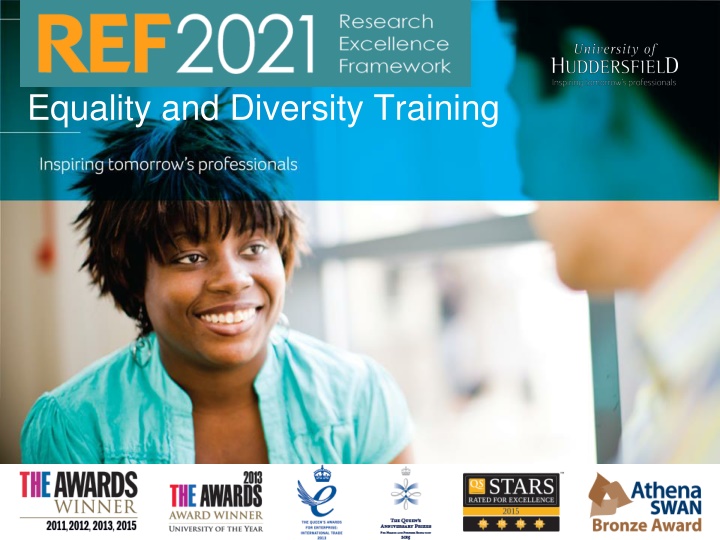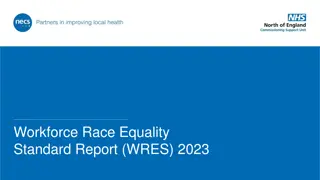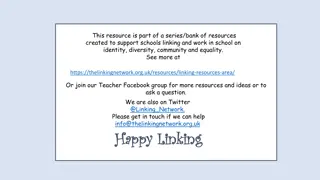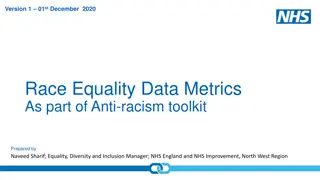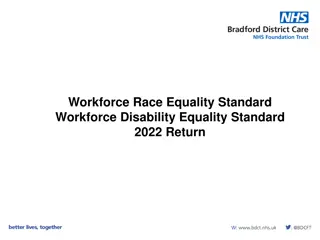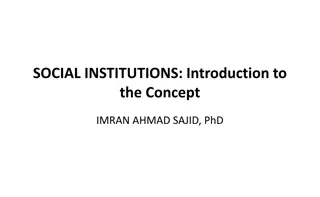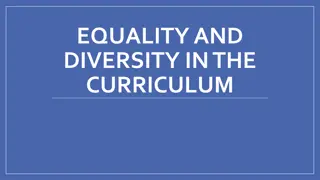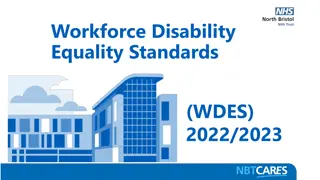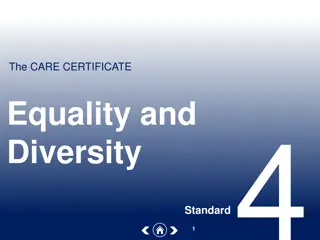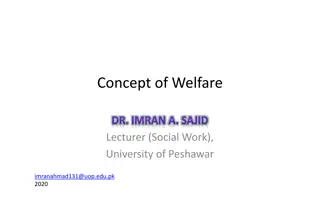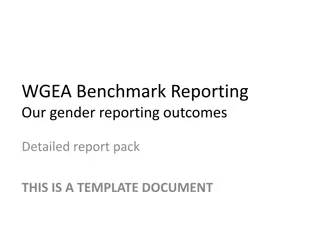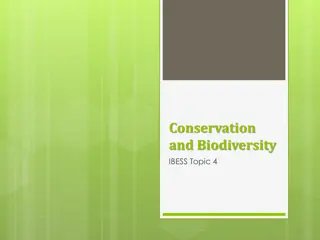Challenges in Staff Selection for Equality and Diversity in Academic Institutions
Despite some progress, challenges persist in the selection of staff in academic institutions, particularly concerning under-selection of minority ethnic staff and those with disabilities. The report highlights disparities in selection rates based on gender, age, nationality, and ethnicity. Addressing these issues is crucial for promoting equality and diversity in the academic sector.
Download Presentation

Please find below an Image/Link to download the presentation.
The content on the website is provided AS IS for your information and personal use only. It may not be sold, licensed, or shared on other websites without obtaining consent from the author.If you encounter any issues during the download, it is possible that the publisher has removed the file from their server.
You are allowed to download the files provided on this website for personal or commercial use, subject to the condition that they are used lawfully. All files are the property of their respective owners.
The content on the website is provided AS IS for your information and personal use only. It may not be sold, licensed, or shared on other websites without obtaining consent from the author.
E N D
Presentation Transcript
Context and aim of training The Funding Bodies have embedded equality and diversity requirements into the REF Training on equality and diversity is a REF requirement for staff responsible for identification of staff to be submitted and for selection of outputs to ensure: We fulfil our legal obligations We promote equality and non discriminatory practice Individuals responsible for selection do not inadvertently make discriminatory assumptions
Concerns from RAE2008 `Selection of Staff for Inclusion in RAE 2008 (HEFCE, 2009) found: Selection rate for staff with declared disability lower than staff without declaration (but low declaration rate) 67% of male permanent academic staff selected but only 48% of women (but lower proportion of women had research record) Women aged 30-50 particularly low rates of selection Selection of staff in black ethnic group lower than other groups (remains unexplained) Women and BME staff less likely to be cited
Concerns from REF2014 `Selection of Staff for Inclusion in REF 2014 (HEFCE, 2015) found: Selection rate for staff with declared disability lower than staff without declaration 67% of male permanent academic staff were selected but only 51% of women The selection gap between men and women increased with age EU and non-EU staff experienced higher selection rates than UK staff Selection of staff in Black and Asian UK and non-EU nationals were lower than in other ethnic groups ECRs had a selection rate of 80%, significantly higher than for non-ECRs 58%. Sex disparity in selection rates is less at the start of careers Staff with contracts of <1FTE were significantly less likely to be selected
Summary paragraph from HEFCE 2015 report Despite the progress in some areas, the remaining equality challenges that remain have been thrown into sharp relief by this analysis. These include the continued under-selection of many black and minority ethnic staff (particularly black staff) and staff with disabilities, and the increase with age in the selection gap between men and women. The detailed analysis contained in this report will inform wider equality and diversity work in the sector, as well as being taken into account in preparations for any future REF.
REF Decision Makers and Advisors Area SRR Advisors Line Managers, Research Group Leaders Line Managers, Research Group Leaders Academics, Internal and External assessors, UOA Coordinators, ADREs UOA Coordinators, ADREs, External assessors Director R&E Decision Makers Associate Deans R&E Associate Deans R&E Independent Researcher REF Oversight Committee Research Outputs REF Oversight Committee Impact Case Studies REF Oversight Committee Institution Environment Statement UOA Environment Statements UOA Coordinators, ADREs REF Oversight Committee IC Panel REF Appeals Panel REF Oversight Committee Individual Circumstances Appeals Requests to Research England for unit reductions in the number of outputs required
Equality Act 2010 and Public Sector Equality Duty 2011 Both as employers and public bodies, HEIs need to ensure that their REF procedures do not discriminate unlawfully against, or otherwise have the effect of harassing or victimising individuals with protected characteristics. HEIs, in carrying out their functions, must have due regard to the need to: a. Eliminate discrimination, harassment, victimisation and any other conduct that is prohibited by or under the Act. b. Advance equality of opportunity between persons who share a relevant protected characteristic and persons who do not share it. c. Foster good relations between persons who share a relevant protected characteristic and persons who do not share it. .
Equality Act 2010 Protected characteristics Protected characteristics: Age Disability Gender Reassignment Race Religion or belief Sex Sexual Orientation Marriage and Civil Partnership Pregnancy and Maternity
Unconscious Bias Your background, personal experiences, societal stereotypes and cultural context can have an impact on your decisions and actions without you realising. Implicit or unconscious bias happens by our brains making incredibly quick judgments and assessments of people and situations without us realising. Our biases are influenced by our background, cultural environment and personal experiences. We may not even be aware of these views and opinions, or be aware of their full impact and implications.
On-line training All members of staff involved in advising and making decisions are required to have completed the following e- learning programmes Diversity in the Workplace and Unconscious Bias , which are available via the staff intranet at https://hud.learnupon.com/users/sign_in . This includes ADREs, UOACs (and deputies), members of REFOC, the REF Appeals Panel and the REF Individual Circumstances Panel.
SRR Staff at the University with significant responsibility for research are those for whom: Explicit time and resources are made available Specific workload allocation for research; access to facilities to carry out research To engage actively in independent research PhD (or other doctoral research degree) qualified; Published research of 2* quality or better as a demonstration of the undertaking of high- quality research of an internationally recognised standard; Member of a Research Centre or Institute within the University It is an expectation of their job role Job description includes research; Annual research objectives are specified in appraisal
IR (Panels A and B) For REF Panels A and B (Units of Assessment 1 to 12) one of the three criteria below must be satisfied: leading or acting as principal investigator or equivalent on an externally funded research project holding an independently won, competitively awarded fellowship where research independence is a requirement. An illustrative, but not exhaustive, list of independent fellowships leading a research group or a substantial or specialised work package
IR (Panels C and D) For REF Panels C and D (Units of Assessment 13 to 34) one of the five criteria below must be satisfied: leading or acting as principal investigator or equivalent on an externally funded research project holding an independently won, competitively awarded fellowship where research independence is a requirement. An illustrative, but not exhaustive, list of independent fellowships leading a research group or a substantial or specialised work package being named as a Co-I on an externally funded research grant/award having significant input into the design, conduct and interpretation of the research
Appeals (SRR/IR identification) The grounds for Appeal are as follows: Exclusion based on personal protected characteristics relating to gender, ethnicity, disability, sexual orientation, religion, age, marital status, maternity leave and paternity leave. Inappropriate application of the criteria for SRR/IR in the University Code of Practice. Inappropriate application of the criteria for SRR/IR as set out in the REF Guidance on Submissions (REF2019/01). The following are NOT grounds for appeal: Credibility of the University s review process and judgements concerning individual staff s research outputs. Allocation of individual s research outputs to a specific UoA.
Appeals Process The appeals process and form for SRR/IR is available on the HR REF2021 website. Staff notified of their right to appeal in the letters sent to them by HR regarding their status as SRR/IR or not-SRR/not-IR, based on the criteria. The REF Appeals Panel will review the information provided by staff submitting appeals. The Panel comprises the Deputy Vice Chancellor (Chair), two Associate Deans Research & Enterprise (outside the member of staff s school) and the Director of HR. All Panel members have not had a role in the SRR/IR process for the individual who has made an appeal
Equality Impact Assessment An EIA is a thorough and systematic analysis to determine whether the institution s processes for: identifying staff determining research independence output selection may have a differential impact on particular groups by reference to one or more protected characteristic(s). For example: % male vs. female identified as SRR % final submitted outputs attributed to BAME staff
Impact of EIA EIAs can influence policy and procedures. Mock REF 2020 outputs selection process will be subject to EIA and may influence the final selection of outputs in each UOA. Plus EIAs are a requirement for the REF submission
A member of staff is not identified as having Significant Responsibility for Research because their Head of Department thought they are in their 30s and would consequently have a less established research record than an older colleague. Discrimination by perception Acting or behaving in a discriminatory way towards a person due to the belief that they have a protected characteristic, whether or not they have such a characteristic.
A member of staff is not identified as having Significant Responsibility for Research because they are undergoing treatment for cancer. Their manager does not want to worry them about work related activities at this point in time. Discrimination arising from a disability Treating a disabled person unfavourably because of something arising from their impairment.
A member of staff is openly undergoing gender reassignment but does not want to declare it for REF purposes. Their HoD approaches them to discuss the matter and when they refuse to declare, they are persistently pursued by staff responsible for the University s REF submission Harassment Unwanted conduct related to ta person s protected characteristic(s) which has the purpose or effect either of violating a person s dignity or of creating an intimidating, hostile , degrading, humiliating or offensive environment for that person
A member of staff questions why their colleagues outputs were not selected for the REF and thinks this might be because the colleagues is gay. When the member of staff complains they are seen as a trouble maker and their submission is restricted. Victimisation Treating a person unfavourably because they have taken (or might be taking) action under the Equality Act or supporting somebody who is doing so
Methods used to communicate REF processes have not been developed in consideration of the requirements of different staff groups. This results in some women who are on maternity leave not being considered in the selection process. Indirect discrimination A practice of policy which may at first appear neutral in its effects, but at closer examinations disproportionately and adversely effects a person s protected characteristic.
Including outputs from a BAME member of staff in the submission because of their ethnicity. Positive discrimination Unlawful action taken by a University to overcome disadvantage for some protected groups who are socially or economically excluded.
A member of staff is not identified as having Significant Responsibility for Research because their partner is a Reverend. Discrimination by association Where a person does not have a protected characteristics themselves but is treated less favourably because of their relationship with someone who does.
A man took an extended period of parental leave and a woman took a period of maternity leave both periods were 6 months, they were both in the same unit of assessment and both met criteria for submission. The man is not submitted because he took extended parental leave. Different treatment of two individuals where the reason for the difference in treatment is a protected characteristic.
Further reading REF 2021 Equality and Diversity Briefing - Equalities Law and the Impact on the REF 2021 is available at: https://staff.hud.ac.uk/portal/ref2021/equalityanddiversity/ along with a copy of this presentation
